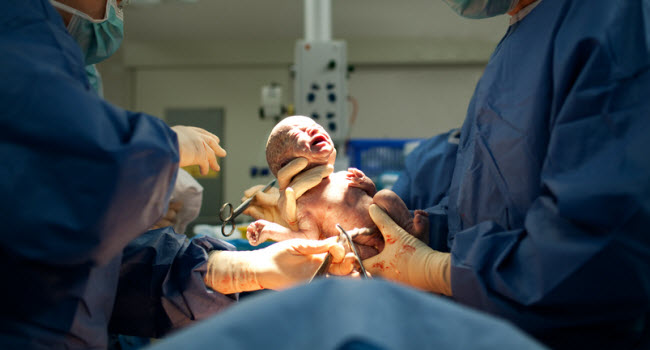
Sponsored Links
My patient is lying on the operating table trembling with fear. The cold, clinical bustle of the OR can feel overwhelming, especially after the warm calm of the delivery room. This is her first baby and a C-section is definitely not on her birth plan. Though I tried every trick in the book to get him to come out the “right” way, the little fella was not cooperating – so it was off to the OR. As I lean over and hold her hand, I can tell by her expression the pain and anxiety she is feeling. There’s so much I wish I had time to tell her…
It’s OK to be scared. I’ve laid on the same table, myself, and I felt naked, numb, and frightened, too. Even though I had performed hundreds of C-sections, when I had to stare up into the spotlights and be on the other side of the scalpel, it was terrifying. Once the surgeon gets started, though, you will feel better. Though you’ll be numb, you’ll still feel strange pulling sensations – especially when the baby comes out. Since you can’t push, the doctors have to literally push the baby out for you by putting pressure on the top of your uterus. You’ll forget all about these strange sensations when you hear the baby cry. And, though your delivery didn’t go exactly like you planned (parenting experiences rarely do), you can likely try again for vaginal delivery with the next delivery. Just as each of your kiddos will be different, your labors often are as well.
You’ll hurt but maybe not in the ways you think. Your incision will burn, but you will have lots of pain meds available. And yes, they will all be safe for breastfeeding. It hurts worse when you change positions, but gets better over the first couple weeks. When the nurse takes your catheter out of your bladder, it feels like your urethra is on fire, but just for a few minutes. Speaking of your bladder, the first few times you pee, you will get this strange pulling sensation as you try to empty your bladder; almost like a bladder infection. This is because the bladder is attached to the uterus, so I have to peel the bladder off the uterus in order to make the uterine incision to deliver your baby. It takes a few days for the bladder to heal up afterward.
Advertisements
Your shoulder will hurt even though I did surgery on your belly. On the day after my C-section, I experienced what I had long explained to my patients as a little “gas pain.” Your abdomen is not used to being exposed to air. The air that enters the belly at the time of the C-section rises in the abdomen, causing a referred pain to the right shoulder. I used to describe this pain to my patients as an aching sensation, but I when I experienced it myself I discovered that perhaps a better term would be an “ice pick like stabbing pain that leaves you breathless.” I was quite sure I was having a heart attack, until my doctor reassured me that this was in fact gas pain. Walking and ibuprofen helped, but be forewarned – this pain is often worse than incisional pain.
You will probably get elephant legs. Everyone knows that pregnant women swell. What you may not realize is that the swelling usually gets worse postpartum, especially if you had a C-section. Your blood volume is increased by 150% during pregnancy. Once the baby has left your body, it no longer has use for all the extra fluid and must get rid of it. When you have a C-section they give you extra fluids to help maintain a healthy blood pressure during the procedure. It takes about 2 weeks for your body to get rid of the fluid, and during that time your swelling will wax and wane quite a bit. I made the horrible mistake of getting on a scale 2 days postpartum only to realize that I actually weighed more than I did when I came in to deliver, thanks to all the swelling.
You should focus on pooping. You are probably thinking that one advantage to a C-section might be that you don’t have to worry as much about BMs as the ladies who had vaginal deliveries, but going “number two” after a C-section can feel like pooping razor blades if you are not careful. The extra fluid, plus breast feeding (which tends to suck all the moisture out of your body), plus the narcotic pain meds (which slow bowel function) can all add up to some serious constipation. I’ll give you stool softeners for you to take while you’re here in the hospital. Stay on them for the first few weeks at home, too. Fluids and fiber are your new best friends. If you go more than a few days with no number two action, then you may want to also add some Miralax or milk of magnesia to get things moving.
But all of these details about bladder spasm, swelling, and constipation will have to wait – right now, I just need to get this baby out. Before I go out in the hall to scrub, I look her in the eyes, squeeze her hand, and say, “It’s going to be okay. I’ll take good care of you and your baby.” She nods back, and I hope she understands. Soon she will be a mom. And, hopefully, once she holds that beautiful boy in her arms, the fear and drama of having a C-section will be just a surreal memory.
by Heather Rupe, DOBoard-certified OB/GYN



Comments